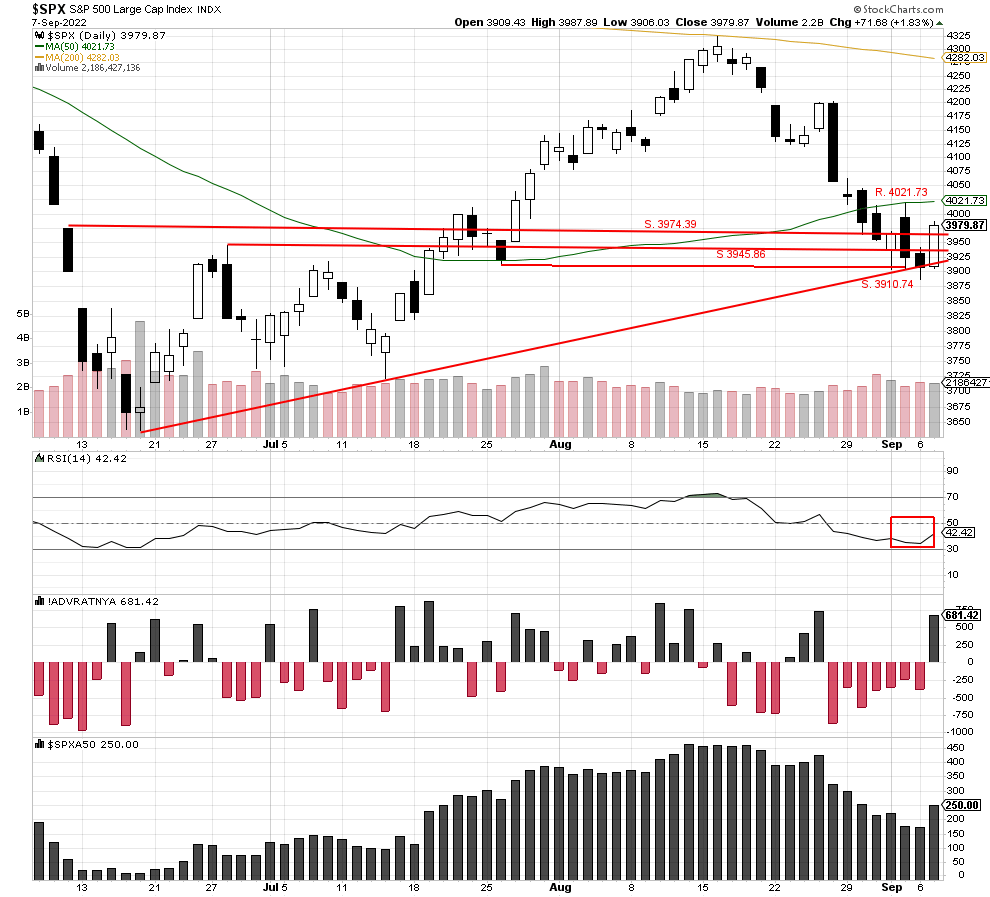Morning Brief

Headline News:
The S&P 500 futures are down 2 points and are trading in line with fair value. The Nasdaq 100 futures are down 18 points and are trading 0.2% below fair value. The Dow Jones Industrial Average futures are up 4 points and are trading slightly above fair value.
Equity futures are not doing much this morning. It’s a bit of a wait-and-see trade with market participants looking to see if the market can build on yesterday’s gain. Participants also await the ECB decision and Fed Chair Powell’s discussion at the Cato Institute’s 40th Annual Monetary Conference later this morning.
In overseas news, British Prime Minister Truss announced that a fracking ban will be lifted and that household energy bills will be limited to GBP2,500 per annum for the next two years.
Japan’s Q2 GDP was better-than-expected at 3.5% year-over-year from the last reading of 2.2% year-over-year. Japan’s deputy chief cabinet secretary said that the yen’s movement is being watched with a strong sense of urgency. USD/JPY -0.2% to 143.46.
Energy complex futures are mixed after yesterday’s sell-off. WTI crude oil futures are up 0.2% to $82.06/bbl. Natural gas futures are down 0.2% to $7.82/mmbtu.
Treasury yields are lower this morning. The 2-yr note yield is down four basis points to 3.41%, while the 10-yr note yield is down five basis points to 3.22%.
(Michael Gibbs, Director of Equity Portfolio & Technical Strategy)
Markets:
The S&P 500 finally reacted to the oversold conditions in the indicators closing higher at 3979.87. The trading came with an 80% day with up volume accounting for 82% of the day’s volume. The index moved off several different support zones that were all together, and the Fibonacci 68% retracement level.
So, the index will now need a follow-through day with another 80% up volume day to confirm and potential new uptrend. The next critical possible resistance level remains the 50-day moving average at 4021.73, and three likely support levels are now in place.
We are currently Intermediate-term bearish and short-term bullish.

John N. Lilly III CPFA
Accredited Portfolio Management Advisor℠
Accredited Asset Management Specialist℠
Portfolio Manager, RJFS
Partner, DJWMG
Windsor Wealth Planners & Strategist
Futures trading is speculative, leveraged, and involves substantial risks. Investing always involves risk, including the loss of principal, and futures trading could present additional risk based on underlying commodities investments.
The Relative Strength Index (RSI), developed by J. Welles Wilder, is a momentum oscillator that measures the speed and changes of price movements.
The advance/decline line (A/D) is a technical indicator that plots the difference between the number of advancing and declining stocks on a daily basis. The indicator is cumulative, with a positive number being added to the prior number, or if the number is negative, it is subtracted from the prior number.
The A/D line is used to show market sentiment, as it tells traders whether there are more stocks rising or falling. It is used to confirm price trends in major indexes and can also warn of reversals when divergence occurs.
The percentage of stocks trading above a specific moving average is a breadth indicator that measures internal strength or weakness in the underlying index. The 50-day moving average is used for short-to-medium-term timeframes, while the 150-day and 200-day moving averages are used for medium-to-long-term timeframes. Signals can be derived from overbought/oversold levels, crosses above/below 50%, and bullish/bearish divergences.
The Dow Jones Industrial Average (DJIA), commonly known as “The Dow,” is an index representing 30 stocks of companies maintained and reviewed by the editors of the Wall Street Journal. The Russell 2000 Index measures the performance of the 2,000 smallest companies in the Russell 3000 Index, which represent approximately 8% of the total market capitalization of the Russell 3000 Index.
The S&P 500 is an unmanaged index of 500 widely held stocks that is generally considered representative of the U.S stock market. Past performance may not be indicative of future results. Keep in mind that individuals cannot invest directly in any index, and index performance does not include transaction costs or other fees, which will affect actual investment performance. Individual investors’ results will vary. Opinions expressed are those of the author John N. Lilly III, and not necessarily those of Raymond James. “There is no guarantee that these statements, opinions, or forecast provided herein will prove to be correct. “The information contained was received from sources believed to be reliable, but accuracy is not guaranteed. Investing always involves risk, and you may incur a profit or loss. No investment strategy can guarantee success. The charts and/or tables presented herein are for illustrative purposes only and should not be considered as the sole basis for your investment decision. International investing involves special risks, including currency fluctuations, different financial accounting standards, and possible political and economic volatility. Investing in emerging markets can be riskier than investing in well-established foreign markets.
This is not a recommendation to buy or sell any company’s stock mentioned above.
US government bonds and treasury bills are guaranteed by the US government and, if held to maturity, offer a fixed rate of return and guaranteed principal value. US government bonds are issued and guaranteed as to the timely payment of principal and interest by the federal government. Bond prices and yields are subject to change based on market conditions and availability. If bonds are sold prior to maturity, you may receive more or less than your initial investment. Holding bonds to term allows redemption at par value. There is an inverse relationship between interest rate movements and bond prices. Generally, when interest rates rise, bond prices fall, and when interest rates fall, bond prices generally rise.
The Nasdaq 100 (^NDX) is a stock market index made up of 103 equity securities issued by 100 of the largest non-financial companies listed on the NASDAQ. It is a modified capitalization-weighted index. It is based on exchange, and it is not an index of U.S.-based companies.



